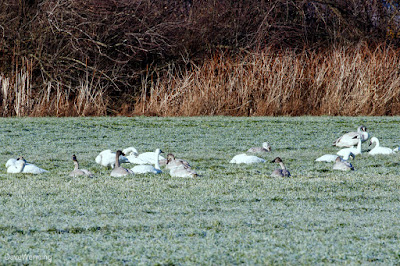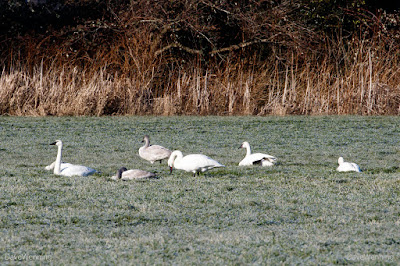Seven Swans....Relaxing
Actually, it was more like seventy swans relaxing yesterday along Best Road in Skagit County, Washington. I had the 100-400 mm lens mounted on the camera. From where I stood, this forty or so was all I could fit in the frame at 100 mm. I spotted this group of Trumpeter Swans (Cygnus buccinator) while heading home after hiking on Fir Island.
Our mornings have been chilly since New Year's, with mostly sunny skies. It was only about 26° F (-2° C) at the time of these photos. That's frost on the grass adding a silvery tinge.
Tundra Swans (Cygnus columbianus) also visit this area in the winter. If you get a close look, the two species are easy to tell apart. The crown of the head on Trumpeters is flattened with the plane parallel to the beak. On Tundra Swans, the crown is more dome shaped. Tundras usually also have a spot of orange or yellow on the beak near the eye.
The grayish birds are juveniles. They will turn white like the adults before the spring migration. The faces of some Trumpeters have a rust stain, derived from iron compounds where they have been feeding.
Trumpeter Swans are North America's largest waterfowl. They usually weigh 15-30 pounds, 7-14 kg with a wingspan of 80 in, 203 cm. To get aloft, they require 100 meters of open water, running across the surface.
A group of swans on open land like this is called a bevy, bank or herd. I like herd for such a pastoral scene. When in flight, they become a wedge or flight.
The scientific name Cygnus is Latin for swan (from ancient Greek kyknos). Buccinator comes from Latin buccinare, meaning to blow a trumpet. Buccinator is also the cheek muscle in humans. It flattens the cheek, aids in chewing food, and, as it happens, is used in trumpet playing.
These birds are common sights in the fields of Skagit and Whatcom counties during the winter. They might also be spotted flying overhead, sounding their calls, as they move from field to field. Best Road is one of the best places to spot them. I also look for them in Cranberry Lake in Deception Pass State Park. They are hard to miss and always a pleasure.



